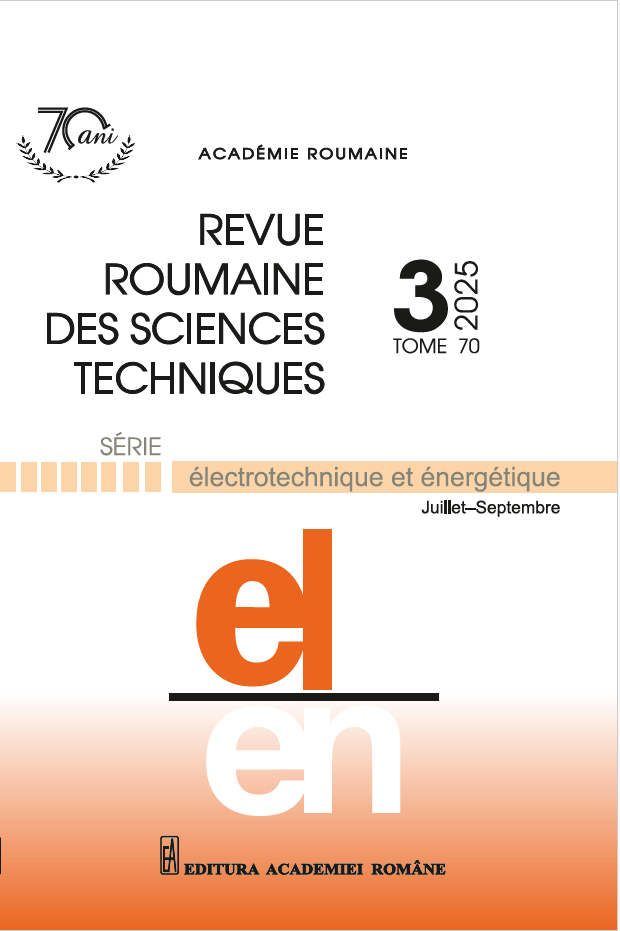USING THE SMITH DIAGRAM IN THE ANALYSIS OF HIGH-FREQUENCY ANALOG CIRCUITS
DOI:
https://doi.org/10.59277/RRST-EE.2025.3.13Keywords:
Smith diagram, Analog circuits, Reflection coefficient, Voltage standing wave ratioAbstract
The main objectives of this paper are to learn how to generate impedances on the Smith chart. The Smith diagram is a commonly utilized graphical technique for circuit applications with high frequencies, providing an innovative method for visualizing complex functions in the complex plane, where impedances are represented, as well as in the polar plane, where reflection coefficients (phase and amplitude) are described. Additionally, this allows for the representation of circles with a constant Q (quality factor), continuous standing wave ratio (SWR), and stability circles. Through examples given below, we’ve shown how the admittances and impedances can be graphically analyzed using the Smith chart.
References
(1) Z. Yi, P. Hu, X.-X. Yang, M. Li, D. Zeng, The transformation of normalization standard of Smith chart for microwave networks with multiple impedance transmission lines, IEEE Microwave and Wireless Technology Letters, 35, 4, pp. 384-387 (2025).
(2) H. Kumar, An innovative approach for microwave circuit design and analysis using fully symmetrical planar Smith chart, IEEE Microwaves, Antennas, and Propagation Conference (MAPCON), Hyderabad, India, pp. 1-4 (2024).
(3) S. Maddio, G. Pelosi, S. Selleri, A brief history of the Smith chart, 8th IEEE History of Electrotechnology Conference (HISTELCON), Florence, Italy, pp. 39-41 (2023).
(4) P. Smith, Electronic applications of the Smith chart, Noble Publishing Corporation (2000).
(5) F. Dellsperger, Smith chart software V4.0 (2017).
(6) D. Blujdescu, Experiments with Fideri, Conex Club (2002).
(7) D. Blujdescu, Smith diagram questions and answers (I and II), Radio Communications and Amateur Radio, Conex Club (2002).
(8) F. Cretu, Radio receivers, PRIM (2007).
(9) K.-C. Chan, A. Hartner, Impedance matching and the Smith chart, RF Design (2000).
(10) ***https://www.microwaves101.com/downloads/smith.PDF.
(11) F. Cretu, About the Smith diagram and some practical applications of it, YO8CRZ / VA7CRZ (2012).
(12) ***https://www.easycalculation.com/engineering/electrical/electrical-admittance.php.
(13) ***http://leleivre.com/rf_gammatoz.html.
(14) ***http://www.antenna-theory.com/definitions/vswr-calculator.php.
(15) ***http://elth.pub.ro/~vasilescu/sisteme_cu_microunde/Introducere_Diagrama_Smith.pdf.
(16) ***http://www.fritz.dellsperger.net/smith.html.
(17) C. Sandu, Contributions regarding the design and construction of wireless electromagnetic energy transmission devices, Ph.D. dissertation, Polytechnic University of Bucharest, Bucharest (2020).
(18) 18. R. Asanache, Contributions regarding the use of S parameters and Smith diagram in the qualitative analysis of analog circuits, Research paper, Polytechnic University of Bucharest, Bucharest (2021).
(19) 19. M. Iordache, M. Stanculescu, R. Asanache, L. Bobaru, S. Deleanu, D. Niculae, G. Rezmeriță, Analog circuit analysis using S-parameters and Smith chart, Matrix Rom Publishing House, Bucharest, ISBN 978-606-25-0771-8 (2022).
Downloads
Published
Issue
Section
License
Copyright (c) 2025 REVUE ROUMAINE DES SCIENCES TECHNIQUES — SÉRIE ÉLECTROTECHNIQUE ET ÉNERGÉTIQUE

This work is licensed under a Creative Commons Attribution-NonCommercial-NoDerivatives 4.0 International License.


